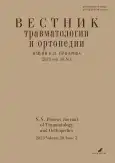Screening examination of the cervical spine in patients with Down syndrome
- Authors: Kuleshov A.A.1, Gubin A.V.2, Sharov V.A.1, Vetrile M.S.1, Lisyansky I.N.1, Makarov S.N.1
-
Affiliations:
- Priorov National Medical Research Center of Traumatology and Orthopedics
- St. Petersburg State University’s N.I. Pirogov Clinic of High Medical Technologies
- Issue: Vol 30, No 3 (2023)
- Pages: 325-334
- Section: Original study articles
- URL: https://bakhtiniada.ru/0869-8678/article/view/218078
- DOI: https://doi.org/10.17816/vto568156
- ID: 218078
Cite item
Abstract
BACKGROUND: Among all the variety of orthopedic pathologies typical for patients with Down syndrome, pathology of the cervical spine, in our opinion, is the most important. Various types of atlantoaxial dislocations can cause significant neurological deficits and decrease patients’ quality of life.
OBJECTIVE: To analyze the results of screening examination of patients with Down syndrome for the presence of cervical spine pathology.
MATERIALS AND METHODS: As part of the screening examination, functional radiographs of the cervical spine in the lateral projection of 60 patients with Down syndrome were evaluated. Priorov NMIC will operate from May 2021 to January 2023.
RESULTS: Nine of the 60 patients tested exhibited craniovertebral pathology. Three patients have Os odontoideum of the C2 vertebra. In five patients, different types of rotational atlantoaxial displacements were found, and one patient had hypoplasia of the occipital condyles associated with basilar invagination of the C2 vertebral dentition.
CONCLUSION: The instability of the upper cervical spine is potentially the most dangerous manifestation of orthopedic pathology in Down syndrome. A screening examination with functional cervical spine lateral projection radiographs is recommended for this group of patients.
Full Text
##article.viewOnOriginalSite##About the authors
Alexander A. Kuleshov
Priorov National Medical Research Center of Traumatology and Orthopedics
Email: cito-spine@mail.ru
ORCID iD: 0000-0002-9526-8274
SPIN-code: 7052-0220
MD, Dr. Sci. (Med.)
Russian Federation, MoscowAlexandr V. Gubin
St. Petersburg State University’s N.I. Pirogov Clinic of High Medical Technologies
Email: shugu19@gubin.spb.ru
ORCID iD: 0000-0003-3234-8936
SPIN-code: 2014-6518
MD, Dr. Sci. (Med.)
Russian Federation, Saint-PetersburgVladislav A. Sharov
Priorov National Medical Research Center of Traumatology and Orthopedics
Author for correspondence.
Email: sharov.vlad397@gmail.com
ORCID iD: 0000-0002-0801-0639
SPIN-code: 8062-9216
Traumatologist-Orthopedist
Russian Federation, MoscowMarchel S. Vetrile
Priorov National Medical Research Center of Traumatology and Orthopedics
Email: vetrilams@cito-priorov.ru
ORCID iD: 0000-0001-6689-5220
SPIN-code: 9690-5117
MD, Cand. Sci. (Med.)
Russian Federation, MoscowIgor N. Lisyansky
Priorov National Medical Research Center of Traumatology and Orthopedics
Email: lisigornik@list.ru
ORCID iD: 0000-0002-2479-4381
SPIN-code: 9845-1251
MD, Cand. Sci. (Med.)
Russian Federation, MoscowSergey N. Makarov
Priorov National Medical Research Center of Traumatology and Orthopedics
Email: moscow.makarov@gmail.com
ORCID iD: 0000-0003-0406-1997
SPIN-code: 2767-2429
MD, Cand. Sci. (Med.)
Russian Federation, MoscowReferences
- Caird MS, Wills BP, Dormans JP. Down syndrome in children: the role of the orthopaedic surgeon. J Am Acad Orthop Surg. 2006;14(11):610–9. doi: 10.5435/00124635-200610000-00003
- Carfì A, Liperoti R, Fusco D, Giovannini S, Brandi V, Vetrano DL, Meloni E, Mascia D, Villani ER, Manes Gravina E, Bernabei R, Onder G. Bone mineral density in adults with Down syndrome. Osteoporos Int. 2017;28(10):2929–2934. doi: 10.1007/s00198-017-4133-x
- McKelvey KD, Fowler TW, Akel NS, Kelsay JA, Gaddy D, Wenger GR, Suva LJ. Low bone turnover and low bone density in a cohort of adults with Down syndrome. Osteoporos Int. 2013;24(4):1333–8. doi: 10.1007/s00198-012-2109-4
- Sergeenko OM, Dyachkov KA, Ryabykh SO, Burtsev AV, Gubin AV. Atlantoaxial dislocation due to os odontoideum in patients with Down’s syndrome: literature review and case reports. Childs Nerv Syst. 2020;36(1):19–26. doi: 10.1007/s00381-019-04401-y
- Spitzer R, Rabinowitch JY, Wybar KC. A Study of the Abnormalities of the Skull, Teeth and Lenses in Mongolism. Can Med Assoc J. 1961;84(11):567–72.
- Lutsik AA, Ratkin IK, Nikitin MN. Kraniovertebral’nye povrezhdeniya i zabolevaniya: monografiya. Novosibirsk: Izdatel’; 1998. 551 р. (In Russ).
- Caird MS, Wills BP, Dormans JP. Down syndrome in children: the role of the orthopaedic surgeon. J Am Acad Orthop Surg. 2006;14(11):610–9. doi: 10.5435/00124635-200610000-00003
- Arvin B, Fournier-Gosselin MP, Fehlings MG. Os odontoideum: etiology and surgical management. Neurosurgery. 2010;66(3 Suppl):22–31. doi: 10.1227/01.NEU.0000366113.15248.07
- Khusainov N, Vissarionov SV, Kokushin D. Craniocervical instability in children with Down’s syndrome. Pediatric Traumatology Orthopaedics and Reconstructive Surgery. 2016;4(3):71. doi: 10.17816/PTORS4371-77
- Kuleshov AA, Shkarubo AN, Gromov IS, Vetrile MS, Lisyanskiy IN, Makarov SN, Chernov IV, Mitrofanova EV, Ponomarenko GP. Surgical treatment for nontumorous diseases of craniovertebral region. N.N. Priorov Journal of Traumatology and Orthopedics. 2018;25(1):36–41. (In Russ). doi: 10.17816/vto201825136-41
- Klimo PJr, Coon V, Brockmeyer D. Incidental os odontoideum: current management strategies. Neurosurg Focus. 2011;31(6):E10. doi: 10.3171/2011.9
- Rowland LP, Shapiro JH, Jacobson HG. Neurological syndromes associated with congenital absence of the odontoid process. AMA Arch Neurol Psychiatry. 1958;80(3):286–91. doi: 10.1001/archneurpsyc.1958.02340090022002
- Gubin AV, Ul’rih EV. Sindromal’nyj podhod k vedeniyu detej s porokami razvitiya shejnogo otdela pozvonochnika. Hirurgiya pozvonochnika. 2010;(3):14–19. (In Russ). doi: 10.14531/ss2010.3.14-19
- McGoldrick JM, Marx JA. Traumatic central cord syndrome in a patient with Os odontoideum. Ann Emerg Med. 1989;18(12):1358–61. doi: 10.1016/s0196-0644(89)80276-8
- French HG, Burke SW, Roberts JM, Johnston CE II, Whitecloud T, Edmunds JO. Upper cervical ossicles in Down syndrome. J Pediatr Orthop. 1987;7(1):69–71. doi: 10.1097/01241398-198701000-00014
- Cros T, Linares R, Castro A, Mansilla F. Estudio radiológico de las alteraciones cervicales en el síndrome de Down. Nuevos hallazgos mediante tomografía computarizada y reconstrucciones tridimensionales. Rev Neurol. 2000;30(12):1101–7. (In Spanish).
- Hengartner AC, Whelan R, Maj R, Wolter-Warmerdam K, Hickey F, Hankinson TC. Evaluation of 2011 AAP cervical spine screening guidelines for children with Down Syndrome. Childs Nerv Syst. 2020;36(11):2609–2614. doi: 10.1007/s00381-020-04855-5
Supplementary files













